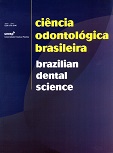Bone repair after osteotomy with diamond burs and CVD ultrasonic tips – histological study in rats
DOI:
https://doi.org/10.14295/bds.2007.v10i3.277Abstract
This study histologically evaluated the behavior of bone tissue of rats submitted to osteotomy with conventional diamond burs in high speed and a new ultrasonic diamond tips system (CVD – Chemical Vapor Deposition), at different study periods. The study was conducted on 24 Wistar rats. Osteotomy was performed on the posterior paws of each rat, with utilization of diamond burs in high speed under thorough water cooling at the right paw, and CVD tips at the left paw. Animals were killed at 0, 7, 14 and 21 days after treatment, followed by removal of connective tissue and bone at the area of osteotomy. Specimens were fixated, demineralized, dehydrated and sectioned for histological analysis by polarized light microscopy (25, 100 and 200x magnification) by two examiners. The results demonstrated that there were no differences in the repair of bone defects between the two different materials employed for osteotomy.Downloads
Downloads
Published
How to Cite
Issue
Section
License
Brazilian Dental Science uses the Creative Commons (CC-BY 4.0) license, thus preserving the integrity of articles in an open access environment. The journal allows the author to retain publishing rights without restrictions.
=================




























